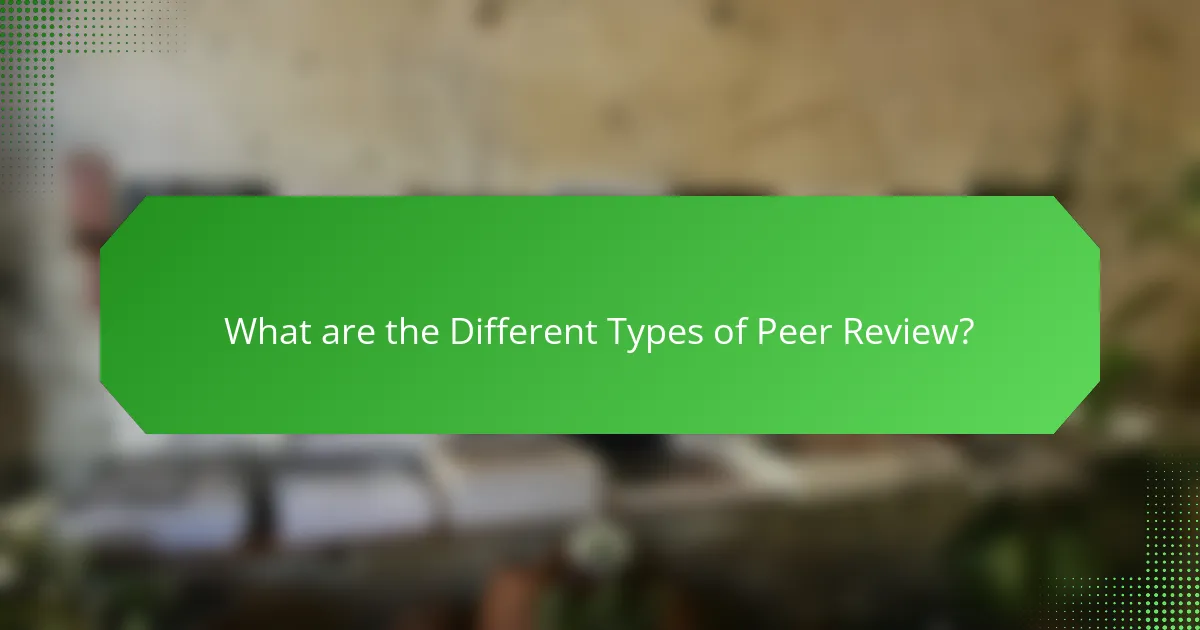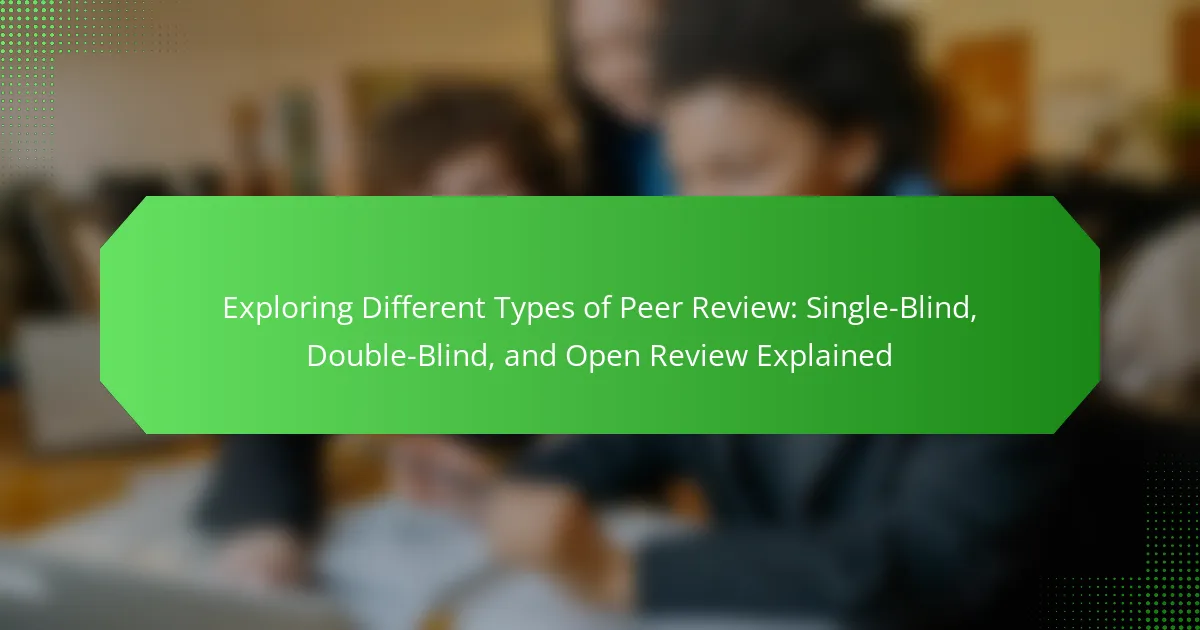Peer review is a critical process in academic publishing, encompassing different types such as single-blind, double-blind, and open review. Single-blind review allows reviewers to know the authors’ identities while keeping the authors unaware of who the reviewers are, which can introduce bias. Double-blind review aims for impartiality by concealing both authors’ and reviewers’ identities from each other. Open review fosters transparency by revealing both parties’ identities, enhancing accountability but potentially leading to conflicts of interest. Each peer review type presents distinct advantages and disadvantages that influence the publication’s quality and integrity.

What are the Different Types of Peer Review?
The different types of peer review are single-blind, double-blind, and open review. In single-blind review, the reviewers know the authors’ identities, but authors do not know the reviewers. This method can lead to bias since reviewers may be influenced by the authors’ reputation. In double-blind review, both the authors and reviewers remain anonymous to each other. This approach aims to reduce bias and promote fairness in the evaluation process. Open review allows both authors and reviewers to know each other’s identities. This transparency can enhance accountability but may also lead to conflicts of interest. Each type of peer review has its advantages and disadvantages, impacting the quality and integrity of the publication process.
How does Peer Review Impact Academic Publishing?
Peer review significantly impacts academic publishing by ensuring the quality and credibility of research. It serves as a critical evaluation process where experts assess the validity and originality of submitted manuscripts. This process helps maintain high standards in scholarly work. A study published in “Nature” by Lee et al. (2013) found that peer review enhances the reliability of published findings. It also promotes transparency and accountability among researchers. Additionally, peer review can influence publication speed, with rigorous reviews potentially leading to longer timelines. Overall, peer review is essential for upholding the integrity of academic literature.
What are the key objectives of Peer Review?
The key objectives of peer review are to ensure the quality and credibility of scholarly work. Peer review evaluates the validity and significance of research findings. It identifies any methodological flaws or biases present in the study. This process helps to enhance the overall clarity and coherence of the manuscript. Additionally, peer review provides constructive feedback to authors for improvement. It also serves to maintain the integrity of the academic publishing process. Research indicates that peer-reviewed articles are more likely to be credible and reliable sources of information.
How does Peer Review enhance the quality of research?
Peer review enhances the quality of research by providing critical evaluation from experts in the field. This process ensures that the research methodology is sound and that the findings are valid. Reviewers assess the originality and significance of the research, which promotes scholarly rigor. Studies show that peer-reviewed articles are more likely to be cited, indicating their influence and acceptance in the academic community. Furthermore, peer review helps identify any biases or errors, leading to improved accuracy in published work. The overall result is a higher standard of quality and credibility in scientific literature.
What is Single-Blind Peer Review?
Single-blind peer review is a process where the reviewers know the identity of the authors, but the authors do not know the identities of the reviewers. This method is commonly used in academic publishing to evaluate the quality of submitted manuscripts. The anonymity of the authors helps to mitigate bias in the review process. Reviewers can provide honest feedback without fear of repercussion. This system aims to maintain the integrity of the review process while allowing reviewers to assess the work based on its merit. Single-blind peer review is prevalent in many scientific journals and is often preferred for its simplicity.
How does Single-Blind Peer Review operate?
Single-blind peer review operates by allowing reviewers to see the identities of the authors while keeping the reviewers’ identities hidden. In this process, submitted manuscripts are evaluated by experts in the field. Reviewers provide feedback and recommendations for publication based on their assessment of the work. The anonymity of the reviewers aims to encourage honest and constructive criticism. This method is common in many academic journals. It helps maintain the integrity of the review process. However, it may introduce bias since reviewers know who the authors are. Studies have shown that single-blind review can lead to varied outcomes compared to double-blind systems.
What are the advantages of Single-Blind Peer Review?
Single-blind peer review offers several advantages. It allows reviewers to provide honest feedback without concern for author retaliation. Reviewers can focus on the content rather than the author’s reputation. This format encourages more thorough critiques, promoting quality improvement in manuscripts. Additionally, it helps maintain a level of anonymity for reviewers, which can lead to more candid evaluations. Research shows that single-blind reviews can reduce bias against less-known authors. This process can also expedite the review timeline, as fewer logistical complexities are involved. Overall, single-blind peer review balances transparency and confidentiality effectively.
What are the potential drawbacks of Single-Blind Peer Review?
Single-blind peer review has several potential drawbacks. Reviewers know the authors’ identities, which can lead to bias. This bias may result in favoritism or prejudice against certain authors or institutions. Additionally, authors may feel vulnerable to negative feedback due to the lack of anonymity for reviewers. This situation can discourage honest critiques. The transparency of the review process may also be compromised, as reviewers may not be as rigorous if they know their identities are revealed. Studies indicate that bias in single-blind reviews can affect the publication rate of certain demographics. Overall, these drawbacks can impact the fairness and integrity of the peer review process.
What is Double-Blind Peer Review?
Double-blind peer review is a process where both the authors and reviewers remain anonymous. This method aims to eliminate bias in the evaluation of scholarly work. In this system, reviewers do not know the identities of the authors. Likewise, authors do not know who the reviewers are. This anonymity helps ensure that the assessment is based solely on the quality of the work. Studies show that double-blind peer review can lead to more objective evaluations. It is commonly used in various academic journals to maintain fairness in the review process.
How does Double-Blind Peer Review work?
Double-blind peer review is a process where both the authors and reviewers remain anonymous to each other. This method aims to reduce bias in the evaluation of scholarly work. In this system, submitted manuscripts are reviewed by experts in the field without knowing the identity of the authors. Similarly, authors do not know who is reviewing their work. This anonymity encourages impartial feedback and promotes fairness in the review process. Studies show that double-blind reviews can lead to more objective evaluations. Journals implementing this method include the “Journal of the American Medical Association” and “Nature.”
What benefits does Double-Blind Peer Review provide?
Double-blind peer review enhances the objectivity of the evaluation process. It minimizes bias by concealing the identities of both reviewers and authors. This anonymity encourages honest feedback and reduces the influence of personal relationships. Studies show that double-blind systems can lead to fairer assessments of research quality. Research published in “Nature” indicates that double-blind reviews may result in more equitable treatment of submissions. This approach can also increase the diversity of perspectives in the review process. Overall, double-blind peer review contributes to the integrity of scientific publishing.
Are there any challenges associated with Double-Blind Peer Review?
Yes, there are challenges associated with Double-Blind Peer Review. One challenge is the difficulty in ensuring true anonymity. Reviewers may recognize authors based on writing style or content. Another challenge is the potential for bias in reviewer selection. If reviewers are not adequately diverse, it can skew feedback. Additionally, the process can be time-consuming. This could delay publication timelines. Finally, the effectiveness of Double-Blind Peer Review relies heavily on the integrity of all parties involved. Any breach of confidentiality can undermine the system.
What is Open Review?
Open Review is a type of peer review where the identities of both authors and reviewers are disclosed. This transparency aims to enhance accountability and foster constructive feedback. In Open Review, reviewers provide their comments and evaluations publicly, often alongside the published work. This approach contrasts with traditional methods, where identities are hidden. Research indicates that Open Review can lead to more thorough and honest evaluations. Studies show increased engagement from reviewers when their names are visible. The practice is gaining traction in various academic fields, promoting a culture of openness and collaboration.
How does Open Review differ from other types?
Open Review differs from other types of peer review primarily in its transparency. In Open Review, both the reviewers and authors are known to each other. This contrasts with Single-Blind Review, where reviewers know the authors but not vice versa, and Double-Blind Review, where both parties remain anonymous. The transparency in Open Review can enhance accountability and encourage constructive feedback. Studies have shown that Open Review can lead to higher quality reviews due to the visibility of the review process. This format allows for greater engagement from the academic community, fostering collaborative improvement of the work.
What are the key benefits of Open Review?
Open Review enhances transparency in the peer review process. It allows reviewers’ identities to be known, fostering accountability. This openness can lead to more constructive feedback. Researchers are encouraged to engage with critiques when they are visible. Open Review promotes collaboration among authors and reviewers. It can improve the quality of published research through diverse perspectives. Studies show that transparency in peer review increases trust in scientific findings. Overall, Open Review contributes to a more robust academic discourse.
What criticisms are associated with Open Review?
Open Review faces several criticisms. One major concern is the potential for bias. Reviewers may be influenced by personal relationships with authors. This can compromise the integrity of the review process. Another criticism is the lack of anonymity. Reviewers may feel pressured to conform to prevailing opinions. This can stifle innovative or controversial ideas. Additionally, there is a fear of retaliation. Authors may retaliate against critical reviewers in future work. This can discourage honest feedback. Finally, there are concerns about the quality of reviews. Open Review may attract less experienced reviewers. This can lead to inconsistent or lower-quality evaluations.
How do Different Types of Peer Review Compare?
Different types of peer review compare based on their transparency and anonymity. Single-blind review keeps reviewers anonymous while authors are known. This can lead to bias, as reviewers may be influenced by the authors’ identities. Double-blind review conceals both authors and reviewers, promoting impartiality. Research shows that double-blind reviews can reduce bias, resulting in fairer evaluations. Open review, where identities are disclosed, fosters accountability but may discourage honest feedback. Each type has pros and cons, impacting the quality and integrity of the review process.
What are the main differences between Single-Blind, Double-Blind, and Open Review?
Single-blind review allows reviewers to know the authors’ identities, but authors do not know the reviewers. In double-blind review, both authors and reviewers remain anonymous to each other. Open review exposes both the authors and reviewers’ identities to one another. Single-blind review may introduce bias from reviewers aware of authors’ identities. Double-blind review aims to reduce bias by keeping identities hidden from both parties. Open review fosters transparency and accountability in the review process. These differences impact the perceived fairness and integrity of the peer review process. Each method has its advantages and challenges in academic publishing.
How do these types affect the peer review process?
Single-blind, double-blind, and open review types significantly influence the peer review process. Single-blind review keeps reviewers anonymous, which may lead to less biased feedback. However, it can also result in a lack of accountability from reviewers. Double-blind review conceals both authors’ and reviewers’ identities. This approach aims to reduce bias related to the authors’ reputation or affiliations. Open review, where identities are known to both parties, promotes transparency and may enhance the quality of reviews. Each type affects reviewer behavior and the overall fairness of the evaluation process. Research shows that double-blind reviews often yield more constructive critiques than single-blind formats.
What Should Authors Consider When Choosing a Peer Review Type?
Authors should consider the transparency, anonymity, and potential biases of each peer review type. Single-blind reviews allow reviewers to remain anonymous, which may encourage honest feedback but can introduce bias. Double-blind reviews protect the identities of both authors and reviewers, promoting impartiality. Open reviews enhance transparency by making both identities known, fostering accountability. Authors should also think about their field’s norms, as some disciplines prefer specific types. Lastly, the speed and efficiency of the review process may vary by type, impacting publication timelines.
What factors influence the choice of peer review type?
The choice of peer review type is influenced by several factors. These factors include the discipline of the research, the preference of the authors, and the policies of the journal. Different academic fields may favor specific peer review types based on their norms. For instance, biomedical research often utilizes double-blind reviews to minimize bias. The authors’ desire for anonymity can also dictate the review type. Journals may have established guidelines that necessitate a particular peer review format. Additionally, the perceived quality and integrity of the review process can affect the choice. In summary, the choice of peer review type is shaped by disciplinary norms, author preferences, journal policies, and quality perceptions.
How can authors best prepare for each type of peer review?
Authors can best prepare for each type of peer review by understanding the specific requirements of each format. For single-blind review, authors should ensure their identities are not revealed in the manuscript. They should focus on clear and concise writing to facilitate understanding. For double-blind review, authors must remove any identifying information from the manuscript, including citations of their previous work. They should also ensure that their research methodology is transparent and reproducible. In open review, authors should be prepared for public scrutiny and feedback. They should engage with reviewers constructively and be open to criticism. Preparing for these types of peer review increases the chances of acceptance and improves the quality of the research presented.
What Best Practices Should Be Followed in Peer Review?
Best practices in peer review include ensuring confidentiality, providing constructive feedback, and adhering to deadlines. Reviewers should maintain the anonymity of authors and themselves, especially in double-blind reviews. Constructive feedback helps authors improve their work and fosters a collaborative environment. Timely reviews are crucial for the publication process and respect the authors’ efforts. Additionally, reviewers should declare any conflicts of interest to maintain transparency. Following these practices enhances the integrity and quality of the peer review process.
How can reviewers ensure a fair evaluation process?
Reviewers can ensure a fair evaluation process by maintaining objectivity and transparency throughout the review. They should assess submissions based solely on merit, without personal biases influencing their judgment. Adopting a standardized evaluation rubric can help reviewers consistently apply criteria to all submissions. Additionally, communicating any potential conflicts of interest is crucial to uphold integrity. Collectively, these practices foster a balanced and equitable review environment. Studies show that transparency and adherence to guidelines significantly enhance the credibility of the peer review process.
What tips can authors follow to navigate peer review successfully?
Authors can navigate peer review successfully by understanding the review process. Familiarize yourself with submission guidelines specific to the journal. Prepare a clear and concise manuscript with a strong introduction and methodology. Address potential reviewer comments proactively in your writing. Respond to feedback professionally and thoroughly after receiving reviewer comments. Maintain open communication with the journal editor throughout the process. Adhering to these practices can lead to a smoother peer review experience.
The main entity of the article is peer review, a critical process in academic publishing that evaluates the quality and credibility of scholarly work. The article explores three primary types of peer review: single-blind, double-blind, and open review, detailing their definitions, advantages, and disadvantages. It highlights how these methods impact the integrity of the publication process and the quality of research, while also discussing best practices for both authors and reviewers. Additionally, the article examines factors influencing the choice of peer review type and provides guidance on how to navigate the peer review process effectively.


